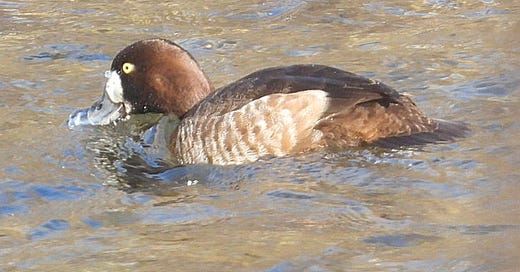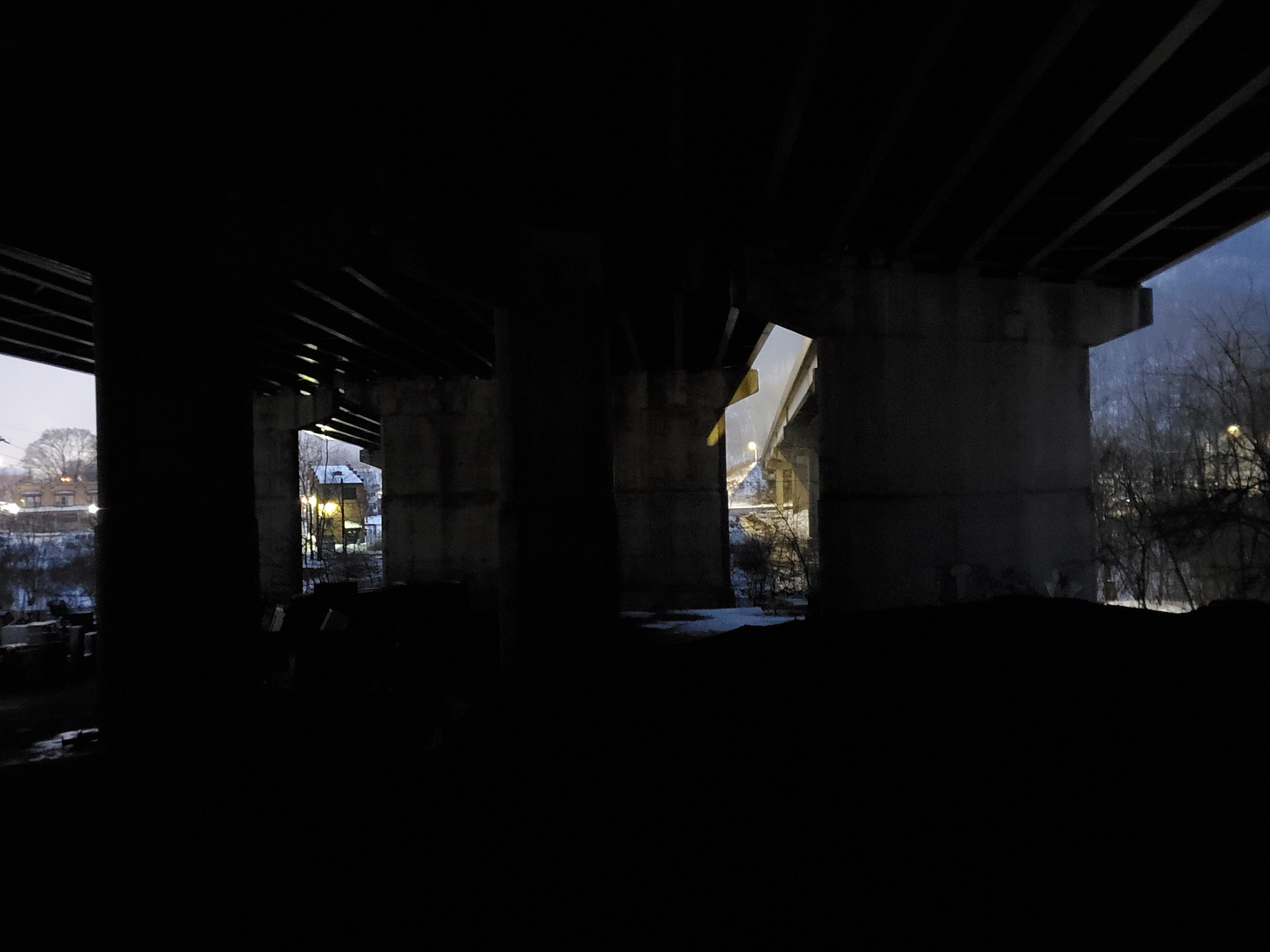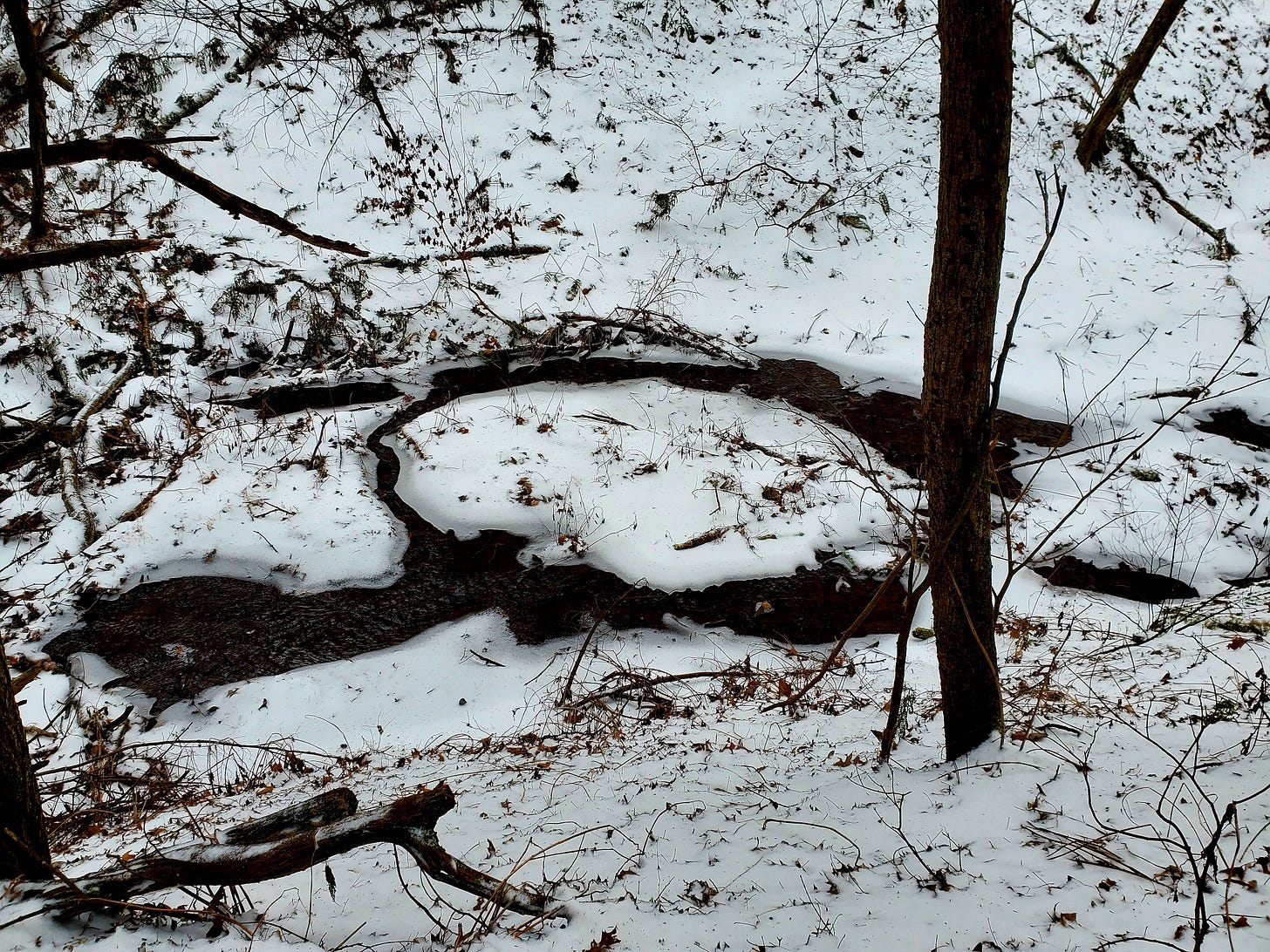End of an Old-Fashioned Winter
Now that was a real winter! I’m not saying it’s over—March could easily dump Nor’easter snows—but the “worst” of it is surely behind us. I put worst in quotation marks because I’m pretty sure that we should be appreciating this rare gift, not moaning and groaning about whether it will ever end.
In my mind, winters like this are normal, and year after year of brown and warm remain aberrations. I realize that my memory is biased—we had some doozies back in the seventies when I was a small child, and those have remained my baseline for Pennsylvania winters ever since.
The consistent earliness of birds last year seems to have presaged the brutal winter. By the fall, you may remember, almost everything was moving south a week to ten days ahead of schedule. Almost nothing lingered, and at least in the frozen wastes of northern Blair County, not a warbler nor phoebe dared to tough it out through January. During a brief thaw at the beginning of February a few vultures poked their heads over the top of the ridge, but they disappeared again for warmer climes (or at least winter roosts to the east) as the post-Valentine’s Day Deep Freeze gave us another week of frigid temperatures. This new round wasn’t quite as cold as January, but with nights in the single digits and daytime highs below freezing, water bodies stayed frozen even as spring waterfowl migration got underway, with intriguing results, as you’ll see a bit further on.
Junkyard Ravens in Love
Sunday, February 16. Song Sparrows are caroling and chasing each other in the hedges around the bank already by 6:30 AM—for them, spring is under way despite the freezing rain and slush.
Suet: A corpse between the rails, another unlucky deer. Three White-throated Sparrows rush noisily out of the privet jungle and head over to the river, as the first of three Winter Wrens starts calling. I haven’t been out here in a week, so the uptick in dawn song is noticeable, the slow swell that seems to happen despite the quality of the weather. Life finds a way, and all that.
I slog onward through the end of the ice storm that dumped an inch or two last night. The weather continues overcast, but American Robins aren’t deterred. Flock after flock flies through the Gap from Tyrone; I count over 200 in all. Food resources are dangerously slim, but there are still plenty of privet berries. Suddenly, the unmistakable wild calls of a Pine Siskin crossing the Gap high overhead, and a few minutes later, two more. Arrivals from the north—the first real winter finches that have showed up, but hopefully not the last.
At a certain point I feel like I’m tracking a Woozle. Other footprints have joined mine, and I’d swear I didn’t see them on the hike out. I trace them back, curious as to where this someone came from. A series of somewhat unsettling occurrences in this area in recent months has me closely attuned to anything out of the ordinary—the curse and blessing of being landowners in times of plague.
The prints abruptly begin as if the person had dropped out of the sky. A little scuffing, some hesitation—at first I think they jumped out one of the five trains that have barreled through here in the last hour, but I eventually surmise that they hopped out of a parked train last night, after the storm ended. Box-car hobo, striding down to the crossing and then their tracks obliterated by the plow.
In the distance, a second-year Bald Eagle circles over the corpse but, seeing me, turns around and heads back upriver. The crows arrive for breakfast.
Common Ravens huddle on a junkyard roof against the icy drizzle. One nuzzles the other, who looks as blissful as my cat Pepe when he’s getting his chin scratched. The nuzzling continues, one’s beak running through the other’s nape and back feathers, as I pass within a few yards of them. Further down, a large Cooper’s Hawk perches in a sycamore.
Fever Fowl
The following week brings the anticipated cold plunge and by its end I’m knocked out by a strange illness. Nevertheless, I drag myself out on Saturday morning for due diligence. It’s in the teens and clear, and despite the chill an actual dawn chorus begins and ends along the tracks before seven. The locals are going at it—Northern Cardinals, Black-capped Chickadees, Tufted Titmice, the wrens, and several others. It quiets down after that, but on the way back I hear the unmistakable kweaah of a Red-headed Woodpecker, the first time I’ve ever detected one down here.
The umpteenth train, rakes screeching to a halt, sends me sliding down into terra nullius and off to the riverbank. I’ll see if anything is on the water here, though I didn’t see a thing on the trip out. As if on command, a Horned Grebe pops up a dozen yards in front of me, bobbing wildly this way and that in the lake-like, almost-still waters of this hidden stretch. Though it’s in the identical spot of the first-in-a-half-century one last December, I can’t believe it’s the same individual, as I’ve checked multiple times since then.
The train finally revs up again and leaves, so I drag myself home at about 75% capacity. I wasn’t expecting a grebe this year. It’s a respectable find, but then my mind starts to play tricks—did I really see a red eye? The bill seemed a bit large. Realizing I need to go back and eliminate rednecks, I grab the camera and head out again, a bit unsteadily.

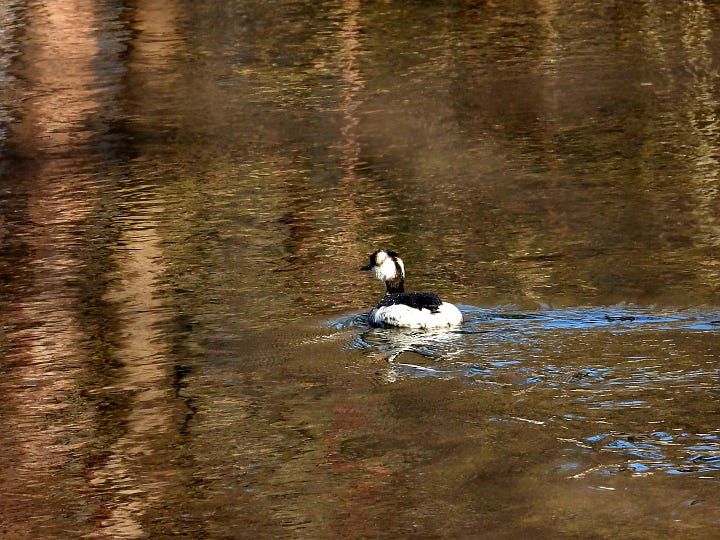
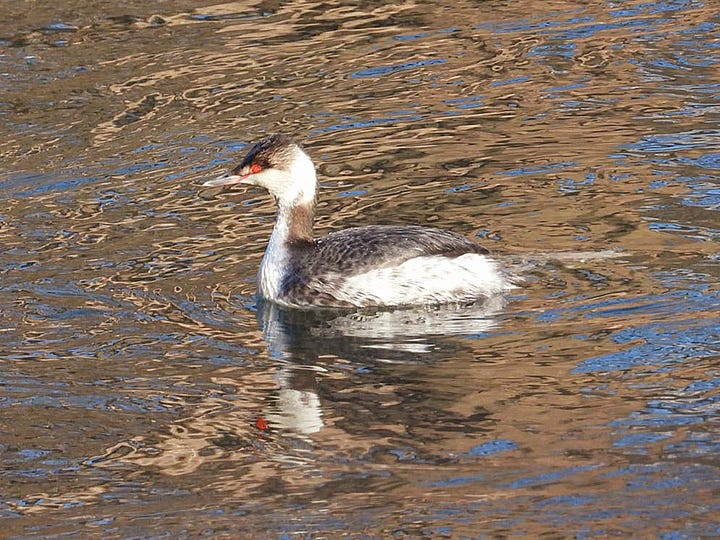
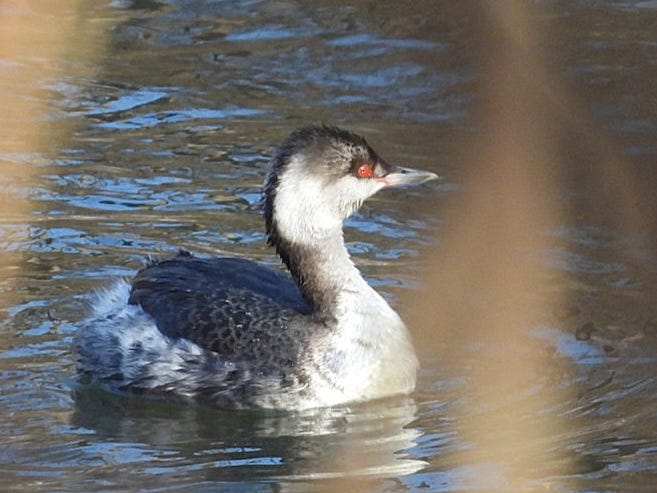
Back in the same spot, it soon obligingly pops up, even closer to me this time. Definitely not a Red-necked Grebe, but glad I checked. As I’m watching, something wholly unexpected floats through my field of view. A female Greater Scaup in the company of two much-larger Mallards!
This is a truly extraordinary sighting for the hotspot: a new species altogether (#232 all-time), and one of the elusive three I’ve been chasing for years. This one, along with Lesser Scaup and Redhead, does not seem to make identifiable flight vocalizations, so it pretty much needs to be detected on the river to make it onto the Plummer’s Hollow list. This would be most likely when all the lakes are frozen up and the Little Juniata River is calm and lake-like. Given typically high water and mild temperatures at the beginning of migration, the conditions are basically non-existent most years. With a warm-up coming, it’s doubtful the window will exist much longer.
The trio floats downstream, heading rapidly out of sight. To get a better photo I scamper east through the brush, then pop back up on the levee, and there they are in front of me, anchored in the riffles and dabbling for food. As soon as they see me, they’re off downstream again, and I leave them to their devices.
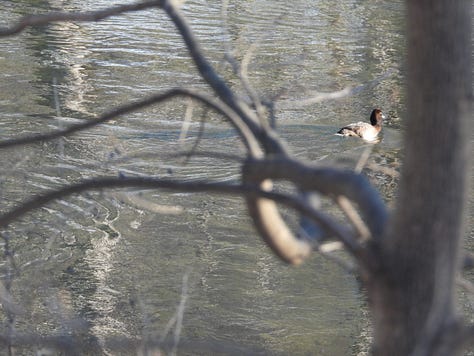
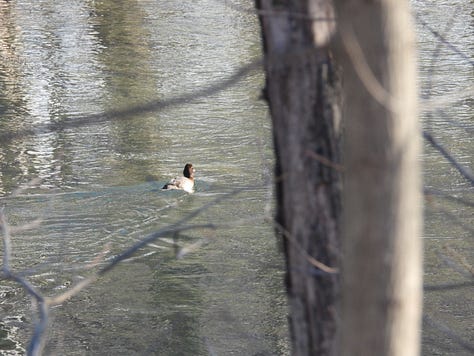

The Floodgates Open
At long last the cold eases. The temperatures on Monday the 24th are predicted to rise above freezing and then some. I figure that warmth we haven’t seen in months will spur a frenzy of activity, and I’m not wrong.
The first new species for the year is an American Kestrel, famished enough to take a break from Sinking Valley (I’d guess) to hang around Eric’s yard, killy-killy-ing several times at first light and then throughout the day.
The warmth doesn’t come all at once, nor is it overwhelming, but by the time I get a break at 3, it’s hit 50, that magic number. I settle on the balcony to wait, with the insistent 3-note song of a titmouse in the background. It flits about, zooming past the balcony in hot pursuit of another. House Finches are singing like crazy, as they’ve been doing for a couple weeks now, setting up territories all about town, and Song Sparrows have also not let up.
Right on cue, a pair of Turkey Vultures appears; they circle low over the Gap, perhaps realizing they’ve been missing out on some ribs. They’re the first I’ve seen since November—Dave saw the only other of 2025, back at the beginning of this month. Up in the air, a pair of ravens cavorts and then two Red-tailed Hawks swirl up among them in a growing thermal.
The finches are flying and singing and chasing in groups of six and eight now. Down in the confluence, a group of mostly male Mallards is getting quite aggressive with each other as the chemicals kick in. This group contains the mostly passive domestic-type male, the piebald one that’s been hanging out since January. Overhead, other groups of Mallards zoom about, some from creek to river and others crossing through the Gap and over the mountains, heading to new areas opened up today with the thaw.
At 4:47 five Canada Geese, the first in ages, circle around and come down for a landing somewhere in or close to town. A Carolina Wren cranks up beyond the confluence, signaling the beginning of the end, but the fun is just beginning. A Ring-billed Gull courses in from the east, fast in the breeze, following the river upstream as these spring migrants seem to like to do. Thirty-three more Canadas arrive, this time circling confusedly over the entrance to the Hollow and then forming a V-line to the west. Caught up in their honking chaos are a couple Brown-headed Cowbirds, another new species for 2025. The geese and cowbirds are presumably locals, like so many others just now emerging from safe places in the valleys to the east to see what’s opening up over here.
Around five, another Turkey Vulture pair emerges above Bald Eagle Mountain by the towers, and then an adult Bald Eagle arrives and circles high over the Gap. A few minutes later, an unmistakable oval comes in fast from the east: the blackbirds are back! As the flock passes overhead, birds of various sizes all lined up in the same direction and flying with purpose, I can make out Common Grackles (FOY!) and Red-winged Blackbirds. A few minutes later, another large flock goes through, this time veering north. I’ve heard of winter roosts as close as State College, so these likely aren’t coming from long distances, but they’re a sure sign that fields are starting to open up, I’m guessing on the flanks of the Front just west of this valley. In coming days and weeks, small groups and pairs will break off to claim local territories—it shouldn’t be long until the first male grackle stakes out his claim to the top of the tallest sycamore at the confluence.
Mallards are flying about everywhere now—we’ve not seen this much activity in ages. At 5:20, as the European Starlings congregate boisterously for the last time on the sycamore and poplar tops, a Killdeer calls from farther away to the south, another first. Two Great Blue Herons fly in from the north together and out through the Gap.
At the end of it, more Turkey Vultures arrive from the east, tilting quickly in the growing dusk. I’m guessing they are gathering at a popular roost spot at the edge of town that’s been empty since last fall.
In all this time, not a robin has been heard, and none have flown over. The last finches and starlings fly to roost and hush. And then, after everyone else has had their say, a single robin starts to yell from over by the interstate.
It’s on.

